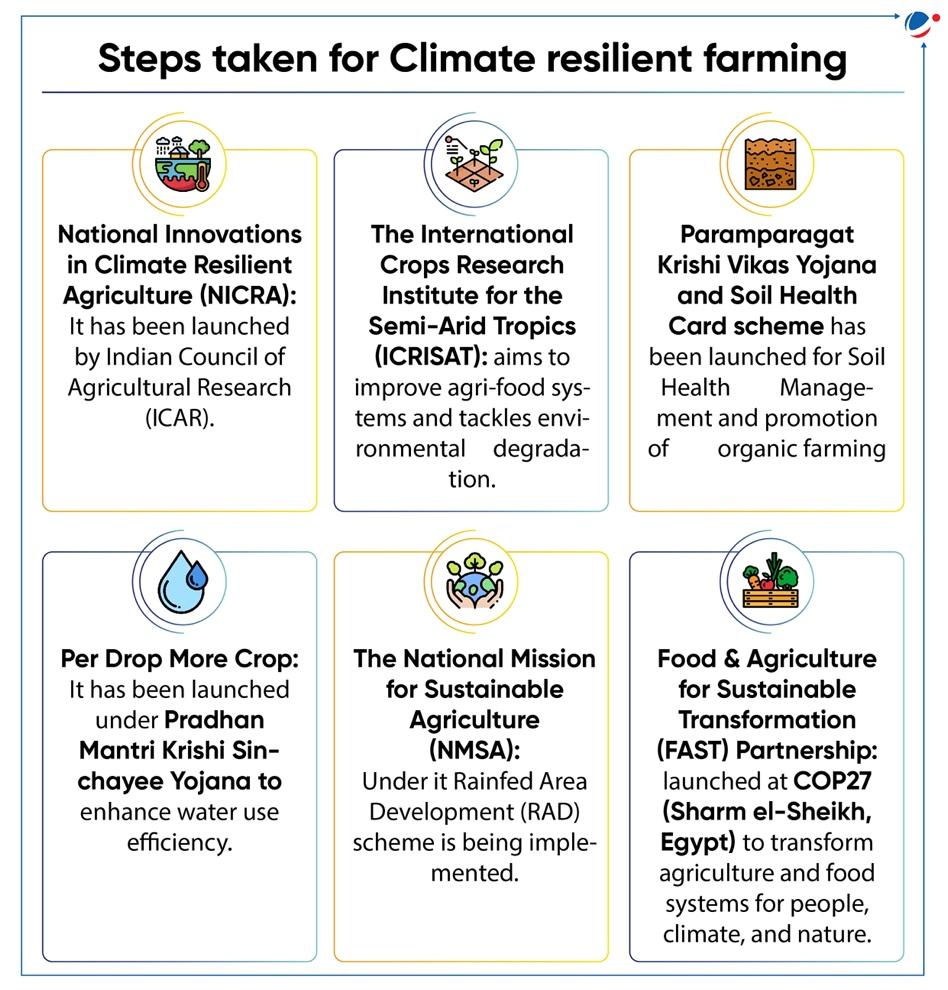Why in the News?
Standing Committee on Agriculture, Animal husbandry and Food processing presented 'Promotion of Climate Resilient Farming’ Report.
Key-highlights of the report
- Climate Change in India
- Increase in Temperature: Increased approx by 0.7 °C between 1901 and 2018.
- Warming of the Indian Ocean: The average Sea Surface Temperature (SST) increased by 1 °C (globally 0.7 °C) from 1951 to 2015.
- Changes in Rainfall: Experienced a decline of approx 6% between the years 1951 and 2015, particularly noticeable over the Indo-Gangetic Plains and the Western Ghats.
- Increase in Droughts: In regions such as Central India, the South West coast, the Southern Peninsula, and North-Eastern.
- Impact of Climate Change on India agriculture
- Crops: Projected decline in rainfed rice, wheat, kharif maize yields by 2050.
- Other crops such as chick pea, cotton and pigeon pea are projected to have beneficial effects due to reduced frost events.
- Horticulture: It is also predicted there will be a shift in crop zones of Apple and other temperate crops.
- Flooding significantly affects tomato and onion cultivation.
- Livestock: The estimated annual milk loss due to heat stress in cattle and buffalo in India is about 1.8–2 million tonnes.
- Impact on animal health by the emergence and re-emergence of infectious diseases, particularly transmitted by vectors, parasites, and protozoa.
- Fisheries: According to the IPCC, If Sea Surface Temperature (SST) increased there will be reduction in plankton concentrations in coastal waters, which could have a negative impact on overall population of fish larvae and adult fish.
- The fish species earlier available only in the middle stretch of the river Ganga, are now available in the colder stretch of the river around Haridwar due to increase in river water temperature.
- Crops: Projected decline in rainfed rice, wheat, kharif maize yields by 2050.
Impact of agriculture on climate
|
About Climate Resilient Farming
- It means the incorporation of adaptation, mitigation and other practices in agriculture which increases the capacity of the system to respond to various climate related disturbances by resisting damage and recovering quickly.
- It will essentially involve judicious and improved management of natural resources viz., land, water, soil and genetic resources through adoption of best practices.
- Significance:
- Reduces hunger and poverty in the face of climate change for forthcoming generations.
- These practices can alter the current situation and sustain agricultural production from the local to the global level.
Challenges in adopting Climate Resilient Farming
- Multidimensional intervention: It involves operating across various scales, making interventions a complex undertaking.
- Also, diverse stakeholders require collaboration between teams with varied backgrounds and methods, posing human resource and policy challenges.
- Skill issues: Lack of knowledge and training due to weak extension services (research-farmer linkages), skill gaps and large-scale illiteracy amongst the farmers.
- Structural issues: Over dependence on rainfall, inadequate supply of seeds, fragmentation of land holding and inadequate post-harvest infrastructure.
- Delayed benefits: Some practices take time to show results, which requires sustained motivation and support.
- Policy issues: Policies like Minimum Support Price (MSP) and subsidised fertilisers leads to monocultures, excessive extraction of water, loss of soil health, and destruction of natural pollinators.

Way Forward
- Creation of Single Nodal Agency at National Level: Issues related to Climate Change and its effects impacting agricultural needs to be handled by a single Authority at the National level.
- Strategies and technologies for climate change adaptation:
- Technology: AI-driven analytics and decision support systems will aid farmers in making informed choices regarding weather patterns and soil conditions. For e.g., Weather Information Network Data System (WINDS)
- Adoption of heat tolerant varieties: for e.g., Adoption of HDCSW-18, DBW-187 (wheat varieties) etc. by Punjab farmers and improved varieties of rice (CR Dhan 201, NICRA Aerobic Dhan 1, CR Dhan 412 etc.)
- Better Livestock Feed management: Some feeding methods include altering feeding time or frequency and modification of diet composition, and training producers in production and conservation of feed for various ago-ecological zones.
- Water management: For e.g., groundwater recharge techniques; adoption of scientific water conservation methods; altering the fertilizer and irrigation schedules; adjusting the planting dates etc.
- Upscaling of proven Resilient Practices: For e, g., nation-wide adoption of Climate Resilient Villages (CRVs) models established under the NICRA project.
- Implementation of measures related to GHG reduction from Agriculture: For e.g., System for Rice Intensification (SRI) has the potential to increase rice yield by 36-49% while using 22-35% less water.
- Awareness at Panchayat level: An aware Sarpanch will act as a force multiplier and in turn educate the farmers who are the front-line warriors about the effects of Climate Change on Agriculture.







